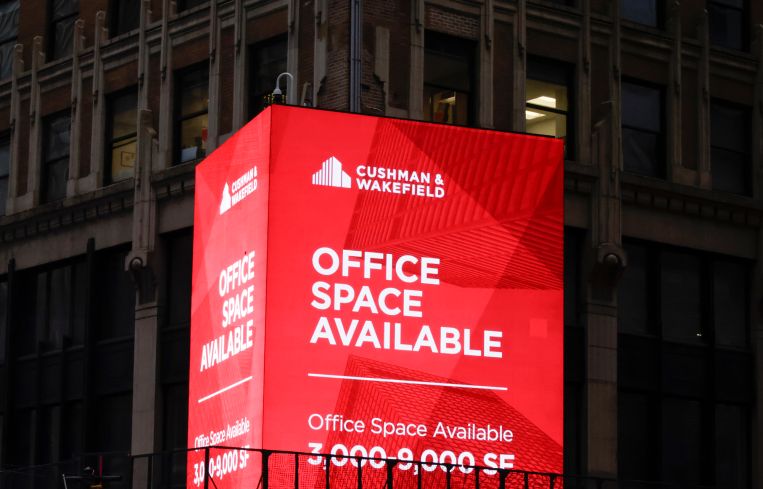Manhattan Office Availability Rate Is Trending Downward — Slowly
Leasing this year has been stronger than it has been since before the pandemic, but the pace isn’t enough to seriously dent a key measure of empty space
By Isabelle Durso September 23, 2025 8:00 am
reprints
2025 isn’t over, but it’s already on track to be the strongest post-pandemic year yet for Manhattan’s office market. That strength is not necessarily reflected in a key metric: availability, which charts vacant and soon-to-be-vacant space.
First, the good news. Office leasing activity in Manhattan totaled 21.1 million square feet during the first half of 2025, representing the strongest first-half performance since 2014’s 21.8 million square feet, according to a recent report from Savills.
The momentum continued into the second half of the year. Law firm Paul, Weiss, Rifkind, Wharton & Garrison expanded to 849,672 square feet at Fisher Brothers and Blackstone’s 1345 Avenue of the Americas in July, for instance, and Verizon leased for 203,000 square feet at Vornado Realty Trust’s Penn 2 in July.
Manhattan office leasing this year is even expected to exceed levels recorded in 2019, right before the pandemic, according to Victor Rodriguez, CoStar’s senior director of analytics in New York City.
Why, then, isn’t Manhattan’s office availability rate cratering as leasing spikes? The first half of 2025 recorded an overall availability rate of 15.4 percent, the lowest rate since January 2021, and Rodriguez said the current rate is at 14.7 percent. But it’s still a far reach from the 11.7 percent recorded in 2019.
“We are definitely [at a] higher [availability rate] than we were in 2019,” Rodriguez told Commercial Observer. “We’re still moving in that positive direction. It’s going to take time to reach there.
“2019 was a healthy leasing environment — people were leasing Class A space along with Class B space,” Rodriguez added. “Today, we are certain that it’s this Class A-plus and this trophy space that’s really driving demand; not as much Class B space being leased.”
In fact, Manhattan’s trophy office buildings — which make up the top roughly 15 percent of the market — are already at pre-pandemic levels in terms of availability, with a 10 percent availability rate during the second quarter of 2025, according to Andrew Lim, director of research in JLL’s New York office.
On the flip side, Manhattan’s Class B buildings are seeing a current availability rate closer to 16.8 percent. “It’s really night and day,” Lim said.
The borough’s office availability rate can vary wildly by area. Midtown recorded an office availability rate of 14.8 percent during the second quarter of this year, while Lower Manhattan recorded a rate of 21.9 percent, according to recent data from Savills.
One of the biggest neighborhood disparities seen during the second quarter, though, was between neighboring areas Hudson Yards and Chelsea. Hudson Yards — which is drawing in tenants like moths to a flame — saw an availability rate of 8.8 percent during the second quarter, while Chelsea confronted one of 30.2 percent, Savills found.
Why? One reason could be because of commuting patterns, according to Matthew Schreck, director of research for Savills’ New York office.
“People are coming back to the office in increasing fashion,” Schreck said. “We’re seeing more mandates, we’re seeing the rate of office attendance pick up. But it’s typically a multistep process [in Chelsea]. You either have to get to the ferry or you have to come into Penn and walk a significant distance. … It’s an extra ask of employees, and that keeps some tenants away.”
Chelsea’s office properties also largely fall in the Class B category, compared to the bright and shiny skyscrapers in Hudson Yards to the north.
And, while Manhattan’s overall Class B availability rate did decline during the second quarter from 19.4 percent to 18.3 percent, the large discrepancy between leasing in the classes may prevent Manhattan’s overall office availability rate from reaching its pre-pandemic rates for a long time — especially as today’s tenants continue to covet high-quality, amenity-filled spaces.
“There’s just a lot of space that is in need of major upgrades, and it’s a very difficult financing environment to get those upgrades, so you have a lot of tired space still sitting in the market,” Rodriguez said.
What are owners doing with that tired space? Conversions, which will likely drive the availability rate down further.
As of July, a total of 15.2 million square feet of office space was converted or being converted to residential use in New York City, according to a report from New York City Comptroller Brad Lander. Those conversions could “absorb more than one-third of the occupancy lost since the fourth quarter of 2019 in the lower tiers of the market and produce approximately 17,400 apartments,” the report said.
“We’re seeing space get taken off for residential conversions, and that certainly helps the availability rate, but the leasing aspect of it all is going to take some time,” Rodriguez said. “So we’re trending in that direction, but it’s going to take possibly another two or three years to get there.”
Conversions as well as new construction take time — and risk.
“When we look at redevelopments and at new construction, we see that the demand is there,” Rodriguez said. “But the timelines might not be worth the squeeze for some owners. So a lot of owners are really just kind of sitting tight because they can’t really get the financing.”
For new office construction specifically, the combination of high costs of labor, construction materials and land, coupled with ordinary rezoning complications, is putting a lot of plans on pause.
That’s not the case for some of the city’s biggest developers, though.
Gary Barnett’s Extell Development is building a 29-story office and retail building anchored by Ikea at 570 Fifth Avenue, where global law firm Simpson Thacher & Bartlett is already getting ready to sign a lease for roughly 700,000 square feet, as CO first reported.
Then there’s Related Companies and Oxford Properties’ 60-story office tower development at 70 Hudson Yards, where financial advisory firm Deloitte inked a deal for 800,000 square feet in April. And we can’t forget BXP’s project at 343 Madison Avenue, which has signed a letter of intent with a “prestigious, investment-grade financial institution” to anchor the property, according to the landlord.
While none of those developments are complete yet, a large portion of their space is already leased up, meaning that even when new construction does happen and adds available space to the office market, it’s getting filled “very, very quickly,” Rodriguez said.
“Because of that level of demand, there will be a negligible impact to availability,” he said. “So I expect the [availability] rate to continue declining over the next year because tenants really want, one, New York, and two, Class A space.
“We started the year above 16 percent and we’re already below 15 percent, so I think it’s reasonable to expect that in a year from now we’ll be below 13 percent if all goes as intended,” Rodriguez added.
JLL’s Lim agreed, saying anchor tenants moving into these new developments will “free up space” for smaller tenants.
“It will start the process of musical chairs, of people moving up when they can,” Lim said. “It makes room for smaller tenants who aren’t anchor size to take the space that those anchor tenants leave behind.”
However, one factor that could impact Manhattan’s office market is New York City’s upcoming mayoral election — specifically the prospect of Democratic nominee Zohran Mamdani winning the vote. The city’s biggest landlords and owners have been divided over Mamdani since his nomination, with some calling for his candidacy’s demise and others resorting to teamwork to try to work with him. Whichever way the cards fall, Rodriguez predicted things will come together.
“The business community had a ton of reservations when it came to Bill de Blasio becoming mayor, and, as mayor, he oversaw some of the strongest office leasing in New York’s history,” Rodriguez said. “So I think the business community often works well with the mayor, even if they don’t see eye to eye on every issue.”
As Schreck added: “History doesn’t always repeat, but it sometimes rhymes.”
Isabelle Durso can be reached at idurso@commercialobserver.com.



